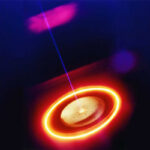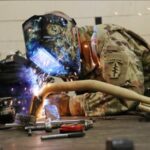As the name implies in Laser beam Machining the source of energy is the LASER (Light Amplification by Simulated Emission of Radiation) . The laser beam focuses optical energy on the surface of the workpiece. A laser beam can be so powerful when used with lens system that it can melt and vaporize diamond as the energy density can be of the order of 105 kW/cm2. This huge amount of energy is released due to some specific atoms having higher energy levels and particular frequency.
Laser Beam Machining Principles with Schematics
Different types of lasers are used in Laser beam machining (LBM). For example – solid state, gas and semiconductor. At times high power lasers are required for machining and welding and in those cases only solid state lasers can provide such power levels.
Ruby-laser or crystalline aluminium oxide or saphire is the most commonly used solid state laser. Generally these lasers are fabricated in into rods having length about 150 mm. Their ends are well furnished to close optical tolerances. Figure below shows a schematic view of laser beam machining process.

(a) Schematic illustration of the laser-beam machining process. (b) and (c) Examples of holes produced in nonmetallic parts by LBM.
A small amount of chromium oxide is added to dope the ruby crystal. A flash of high intensity light , generally Xenon-filled flash lamp is used to pump the laser. To fire the xenon lamp a large capacitor is required to be discharged through it and 250 to 1000 watts of electric power is needed to do this. The intense radiation discharged from the lamp excites the fluorescent impurity atoms (chromium atoms) and these atoms reaches a higher energy level. After passing through a series of energy levels when the atoms fall back to original energy level , an intense beam of visible light emission is observed. This beam is reflected back from the coated rod ends and make more and more atoms excited and stimulated and return to ground level. A stimulated avalanche of light is obtained which is transmitted through the coated part (~80% reflective). This light which is highly coherent in time and space has a very narrow frequency band, is highly in phase and quite parallel. If this light is focused in association with ordinary lenses on the desired spot of the w/p, high energy density is gained which helps to melt and vaporize the metal.
Advantages of Laser Beam Machining
· No tool wear as there is no direct contact between tool and workpiece.
· Metal and non-metals (e.g plastics and rubbers) irrespective of their brittleness and hardness can be machined.
· laser beam can go through a long distance as a result LBM can be used to weld, drill or cut areas which are difficult to reach.
· laser beam welding gives the opportunities to weld/cut magnetic as well as heat treated materials without losing their properties. (some change in the properties is observed in the heat affected zone).
· Any environment is suitable for laser beam machining – through transparent medium and magnetic fields.
· Very little distortion is observed and tow materials can be easily joinedtogether. ( vaporization of the metal is not expected so it must be avoided).
· difficult-to-machine or refractory materials can be drilled.
· Micro sized holes can created in all types of materials.
· Energy obtained is of high density as a result high heat is obtained.
· Beam configuration and size of exposed area is easily controllable.
· Precise location of the spot is ensured.
· By applying unidirectional multiple pulses deep holes of very short diameter can be drilled.
Disadvantages of LBM
· The initial cost is very high and lifespan of the flash lamp is short.
· The safety procedures are needed to be followed very strictly.
· Material removal rate is not up to the mark.
· While machining some plastics bum or char is noticed.
· Too deep holes are not possible to drill.
· Machined holes are not round shaped or straight .
· Overall efficiency is very low . (0.3 ~0.5 %)
Applications
· Welding of non-conductive and refractory material.
· Cutting complex profiles for both thin and hard materials.
· Used to make tiny holes. Such as the holes in the nipples of baby feeder.
· Mass-micro machining
· Can be used for dynamic balance of rotating parts.
· Some special heat treatment of materials.
· For producing fine and minute holes.


